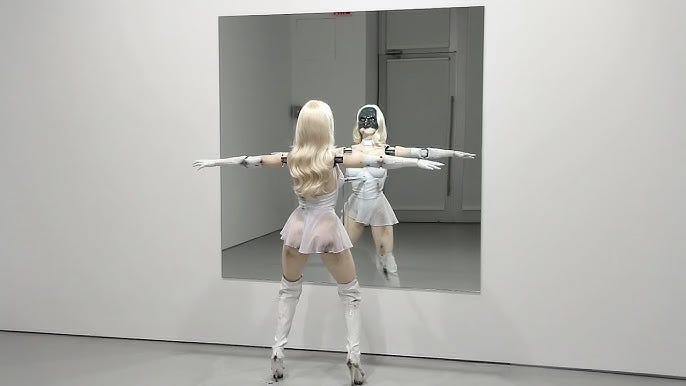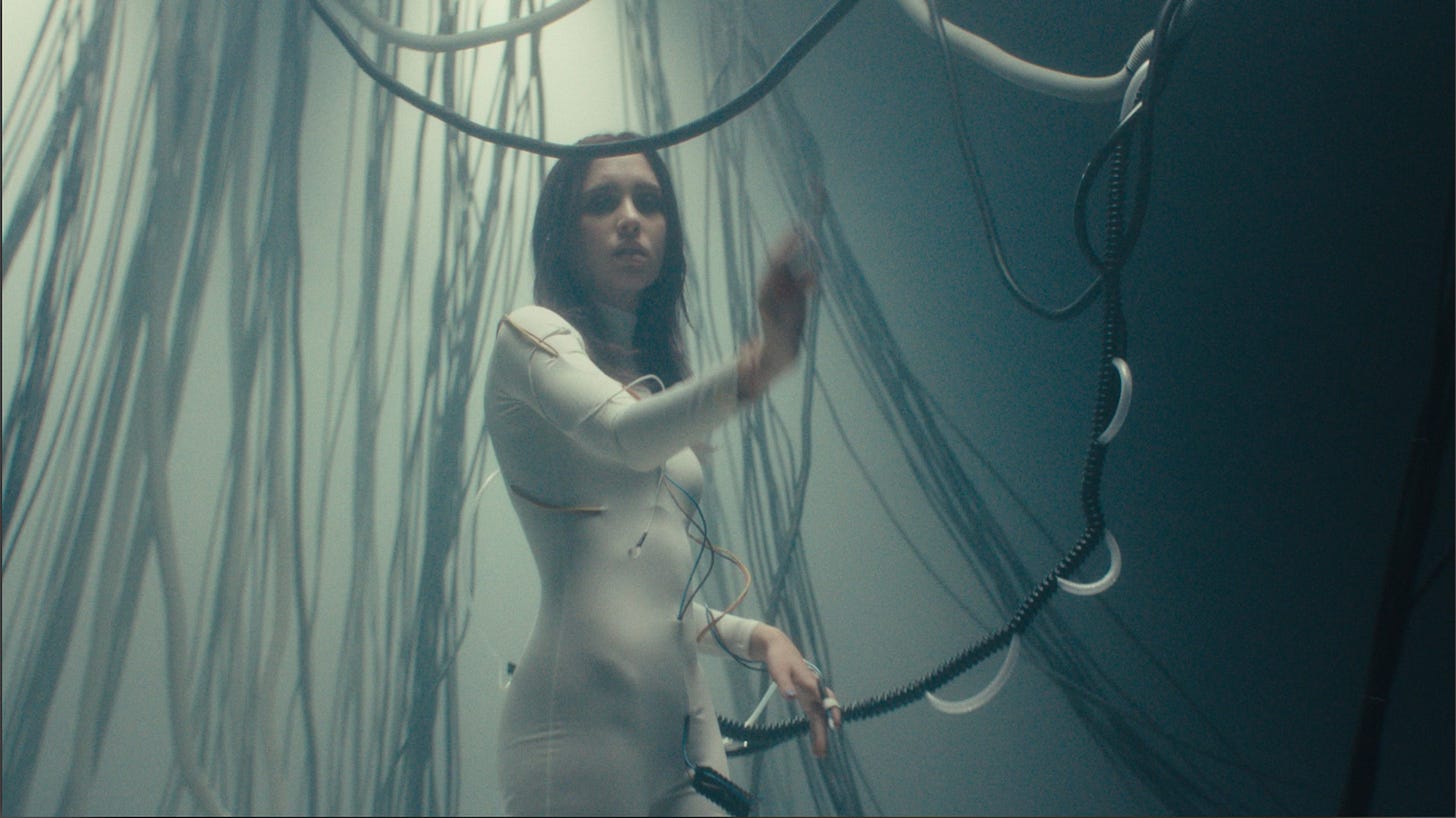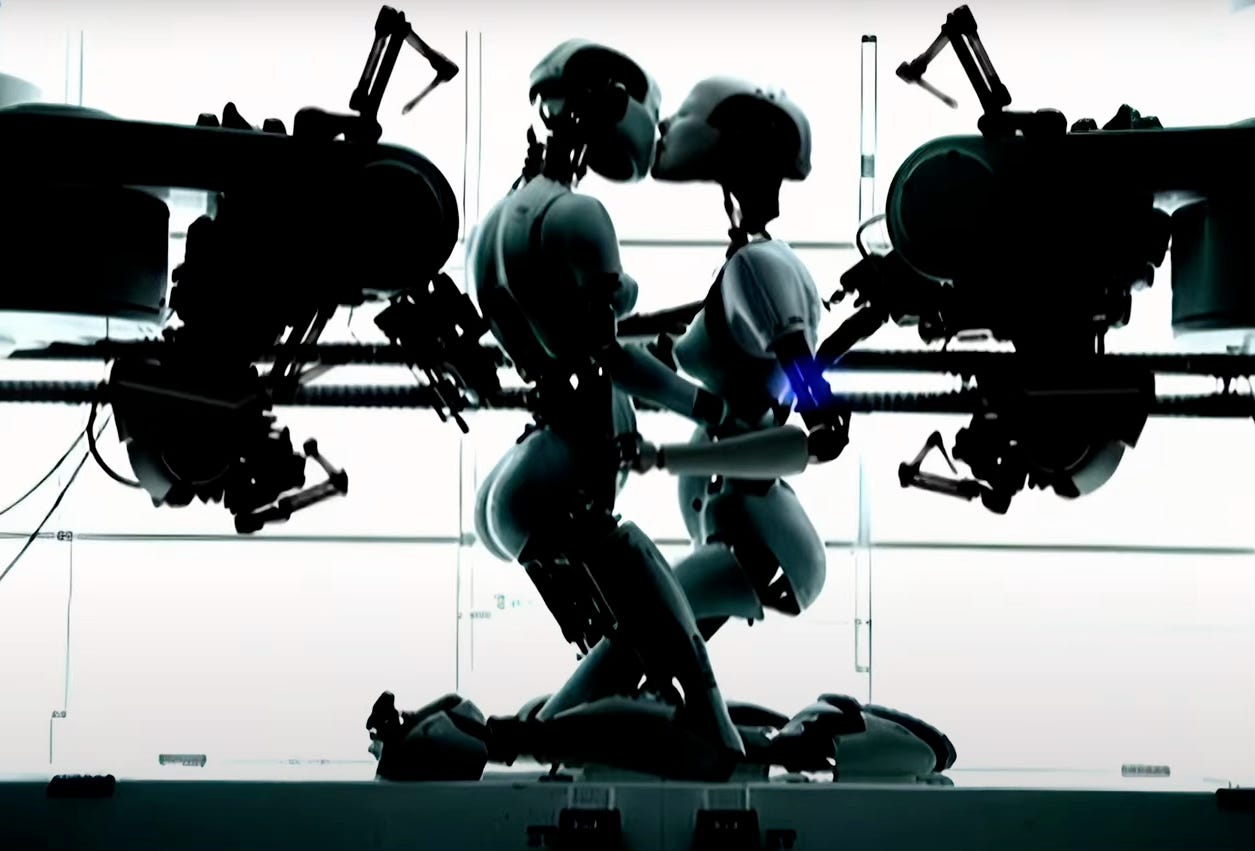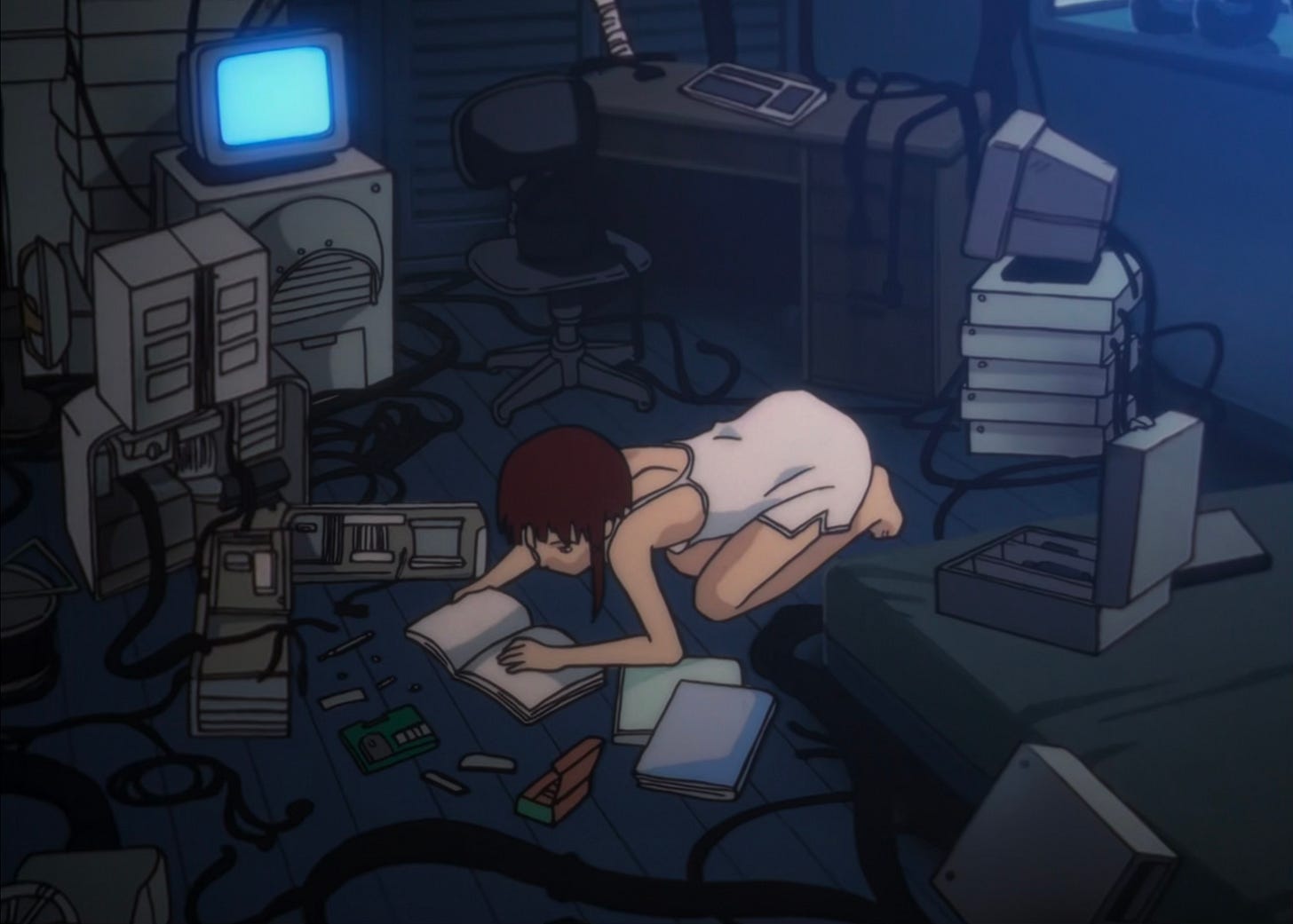003: Girlbots I
Part one of two on The Ginny Suite, the TESCREAL bundle, “Serial Experiments Lain” and other cyberfeminist considerations.
Welcome to Part One of Girlbots, Part Two is now live, here. Subscribe to receive future essays about art + technology. — Michelle 🩸

In 2008 Lisa Nakamura published Digitizing Race, a book that takes aim at the “digital divide discourse that persistently envisions users of color as backward and uninvolved in technology” and challenges the equally popular assumption that envisioned girls as “avid users but not producers, as consumers but not creators” on the internet.1 Sixteen years later, not much has changed: Internet usage is roughly equal across race and gender, with white and black women in a slight lead. But despite earning better grades in STEM courses and indicating interest, young girls are less likely to pursue careers in STEM. In fact, a 2023 Gallup study noted that this divergence is especially marked when it comes to interest in careers in “computers and technology,” where young men lead by 28 percentage points. I doubt any of us are surprised.
It’s no news that there remains a deep cultural bias that characterizes the technical sciences as uniquely “masculine” and therefore beyond the natural abilities or interests of young women. As the industry becomes more bro-ish and hostile to women, we make self-conscious jokes like “women in STEM!” and “Girl Math!” In pop culture, women and tech seem to only meet as depictions of subservient cyborgs, sexbots and gynoids to embody the apex of high-tech. Our culture struggles to imagine, much less encourage and make room for, legitimate encounters between women and technology. And yet, the more advanced a technology, the more overtly feminine it becomes. Technology is “in some ways always implicated in the feminine. It is young; it is thingly.”2

From Amazon’s Alexa to Apple’s Siri, the men designing and promoting the so-called future know that the most efficient way to market their products to a skeptical public is to disguise them as women. The most advanced technological products are marketed as not only intelligent and versatile, but also serviceable, obedient and young (new). At best, we might say the Men of STEM simply struggle to separate their visions of technological progress from their idea of the perfect woman. At worst, we’re forced to assume that they see no difference between progress and optimized exploitation. Whatever the case may be, the futurist vision of advanced technologies shares an uncanny resemblance to the conventional idea of the perfect woman.
Tesla’s latest presentation of its humanoid robots gave Elon Musk the chance to exclaim that the Optimus machine, “can do anything you want!” After the audience was treated to footage of the robot leaning down to serve drinks, watering plants and doing housework. He continued: “It can be a teacher, babysit your kids, walk your dog, mow your lawn, get the groceries, be your friend.” As futuristic as it all sounds, what Tesla produced is simply a cheaper (and perhaps more exploitable and abusable) version of a housewife or a domestic worker.
What I find most fascinating about the specific bias that separates women and technology is that the reality couldn’t be more opposite. Walsh, again: “Women have always been at the interface of communication technology: from telephonists and telegraph operators to ‘computers,’ the early coders whose keytapping associations with secretarial work tagged the profession female.” Look up how rope core memory was woven for the Apollo Guidance Computer. Look up Ada Lovelace. Watch Hidden Figures (2016). Did you know that computing power was once measured in the number of hours it would take a female computer to do the job? A unit of measurement called a kilo-girl. Forget “women in STEM.” Women are STEM.
In her 1994 conference, “The Feminine Cyberspace,” proto-cyberfeminist and scholar Sadie Plant argued that, “You can look back over the whole history of feminism and begin to see some emergent pattern whereby the status of machinery, particularly in terms of communication, and the status of women have actually developed concurrently.” Plant told a riveting story of how “machines begin to learn how to learn, systems begin to access their own controls and make contact with each other as they begin to hack into their own functioning and explore their own intelligence.” She concludes that this is true of both machines and women.
While I find this narrative lacks intersectionality and tells too triumphant a story, it does point to the interwoven development of technology and gender. Women are expected to be a lot of things: “mirror, screen, commodity, means of communication, means of production, carrier of water, weaver of the cloth, carer, whore, machine assemblage, Plant continued. “In other words, in service of the species.” You could argue that to be feminized is to be subordinated in service of the species.3 At least that’s what some feminists argue when they discuss the parallels between digitization and feminization.
In the chapter on “zany” from Our Aesthetic Categories, author Sianne Ngai declares that we are living in a moment in which “labor that was not always viewed as especially feminine but that for two centuries has been very much so, is just beginning, slowly but noticeably, to lose its gender specificity.”4 As capitalism expands its scope of extraction, more and more people are subordinated in service of the species in ways previously exclusive to women. Work itself has become more feminized as markets infiltrate domestic labor and affective labor is pulled into the workplace. Gone are the days of clocking in and out. Now you have to smile, network and manage relationships as service, culture, information and communication industries become the new normal. In 1994, Plant summarized the early paranoias around the digitization and feminization of work by quoting a man she heard on television saying: “Women and robots are taking our jobs!”

In Stacey Skolnik’s experimental novel, The Ginny Suite (2024), digitization and feminization are taken to their most horrific extremes. Set in the near future, a new illness called Sunnyvale Syndrome is affecting only women with symptoms of submissiveness and aphasia. Is it a viral infection? Something you get from your phone? The men you sleep with? That all remains a mystery. What is somewhat clear is that the protagonist is looking for her estranged friend, Virginia. Through the book’s many fragments we stumble upon stories of aphasic sex bots and similarly afflicted women struggling with Sunnyvale Syndrome who are completely reliant on their male partners. Ginny is one of them, or perhaps both? The only thing we ever learn about Ginny is that she keeps a secret journal where she tracks how she loses the ability to speak, how her boyfriend teaches her what her name is and what she likes, how to give him head and so on.
In an interview for Document Journal, Skolnik said she thinks people have a naïve idea of what technological singularity might mean: “I think that we continue to just incorporate it into our own bodies and our own selves. Human beings will become more and more indistinguishable from the technology.” The Ginny Suite asks, what if we turned humans into robots instead of the other way around? Once again, I am reminded of Sadie Plant’s words: “The machines and the women, both of them together, have had to promise to honor and obey.”
In the first episode of the 1998 animated series, “Serial Experiments Lain,” (🔗) the show’s namesake protagonist talks to her Navi, a computer. Lain issues commands and the Navi responds in a female customer service voice. Lain is your average 11 year old girl who feels alienated from her peers and unsure of her place in the world. The show begins with the dramatic suicide of one of her classmates, Chisa, who seems to have been driven to her death by some unknown force she encountered in The Wired, the show’s version of the internet.
As she walks around Tokyo, Lain is acutely aware of the buzzing telephone cables overhead. The morning light glows through her bedroom window in the same shade of blue as her Navi screen. The city’s late-night skyline twinked like rows of server stacks. The whole world is part of the computer’s infrastructure – lending its telephone wires, train tubes, and resources to The Wired. Almost every episode opens with a blurry shot of Shibuya Crossing and Lain is repeatedly depicted in deep contemplation of the telephone wires she sees from the train window on her way to school. This is a story about networks, circulation, information and a girl.
When Lain first begins to tinker with her computer, her sister walks into her room to find the disemboweled Navi on the floor while Lain is operating in her slip. She has to beware of static electricity, Lain explains, friction is the enemy. By the fourth episode, the machine has metastasized, growing out of the corner of her bedroom window like a tumor. Her space is overwhelmed by server stacks, cables, coolant-tubes, screens, holograms, and wires. As Lain spends more time on her Navi she learns how permeable the line between her world and The Wired’s truly is. “I’ll be able to enter it soon,” she tells her dad. “In full range. Full motion. I’ll translate myself into it.”
The people around her begin to notice how Lain’s demeanor changes drastically during conversations. Her outline appears doubled and her voice echoes as if dubbed as if one a Lain superimposed herself over the other. Her friends and family confront her over things she said or did but simply cannot remember and we soon learn that there is, in fact, more than one Lain. Her connection to The Wired unleashed these “other Lain’s,” alter-egos, copies, or duplicates. “The very material notion of communication systems, information systems, of the body and the computer,” said Plant, are “collapsing in on each other.”
We all know that being online is aptly suited to the exploration of a decentralized identity. It disrupts common notions of presence that open the door to minor experiments in omnipresence and multiple identities. But, if digitization is itself a process of feminization, Lain’s union with The Wired can also be read as a coming-of-age story. She is becoming a woman. 🌐
📝 Recently published: I wrote some wall text for my friend’s first solo show, read here — my essay on the sales bros of the Manosphere is live on the Lux Magazine website and you can read it print as well — I wrote about a Puerto Rican artist and dancer for Burnaway, also forthcoming print issue — Plus, one of my weirdest and most vulnerable essays is now live on Dirt.
🔗 Recommendations: an anthology book on indigenous experimental cinema — Field of Contemporary Art diagram by e-flux — this 1958 TIME magazine cover story hailing the beauty industry as “recession-proof” (full feature begins on p.86) — Jenna Bliss’s True Entertainment (2023), a fake reality tv show that’s basically “Gallery Girls” for art handlers, on view at Amant Foundation in Brooklyn.
Lisa Nakamura, Digitizing Race: Visual Cultures of the Internet (2008). pages 14 and 50.
JoannaWalsh, Girl Online: A User Manual (2022) p.138.
Andrea Long Chu offers a similar argument in her essay-book, Females (2019): “The thesis of this little book is that femaleness is a universal sex defined by self-negation, against which all politics, even feminist politics, rebels. Put more simply: Everyone is female, and everyone hates it."..’ll define as female any psychic operation in which the self is sacrificed to make room for the desires of another….in all cases, the self is hollowed out, made into an incubator for alien force.” p.11.
Sianne Ngai, Our Aesthetic Categories: Zany, Cute, Interesting (2012). p. 209.





I'd recommend the 2022 movie Clock on Hulu, directed by Alexis Jacknow - would love to see how you perceive its very woman-centric technology.
"“In other words, in service of the species.” You could argue that to be feminized is to be subordinated in service of the species" — yes!!! i've been writing about donna haraway this week and trying to understand something and this line really helped it click.